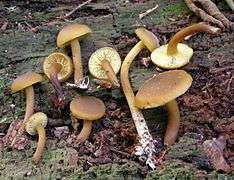Callistosporium luteo-olivaceum
| Callistosporium luteo-olivaceum | |
|---|---|
 | |
| Scientific classification | |
| Kingdom: | Fungi |
| Division: | Basidiomycota |
| Class: | Agaricomycetes |
| Order: | Agaricales |
| Family: | Tricholomataceae |
| Genus: | Callistosporium |
| Species: | C. luteo-olivaceum |
| Binomial name | |
| Callistosporium luteo-olivaceum (Berk. & M.A.Curtis) Singer (1946) | |
| Synonyms[1] | |
| |
Callistosporium luteo-olivaceum is a species of agaric fungus in the family Tricholomataceae. It was originally described in 1859 as Agaricus luteo-olivaceus by Miles Joseph Berkeley and Moses Ashley Curtis in 1859. Rolf Singer transferred it to Callistosporium in 1946. The fungus has an extensive synonymy.[1] Although rare, C. luteo-olivaceum is widely distributed in temperate and tropical areas of Europe and North America.[2] In 2014, it was reported growing in pine forests in Western Himalaya, Pakistan.[3]
References
- 1 2 "GSD Species Synonymy: Callistosporium luteo-olivaceum (Berk. & M.A. Curtis) Singer". Species Fungorum. CAB International. Retrieved 2014-07-23.
- ↑ Bas C, Kuyper TW, Noordeloos ME (1995). Flora Agaricina Neerlandica – 3. CRC Press. p. 104. ISBN 978-90-5410-616-6.
- ↑ Saba M, Khalid AN (2014). "First report of Callistosporium luteoolivaceum from Western Himalaya, Pakistan". Mycotaxon. 129: 73–77. doi:10.5248/129.73.
External links
This article is issued from Wikipedia - version of the 10/21/2016. The text is available under the Creative Commons Attribution/Share Alike but additional terms may apply for the media files.